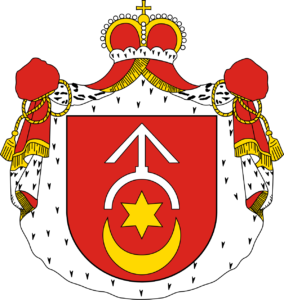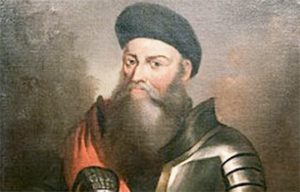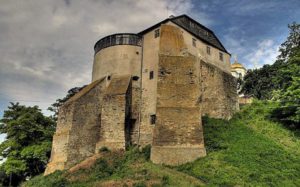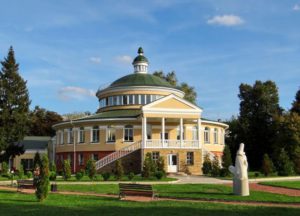
The family of Dukes Ostrogski left their mark in history of both the Grand Duchy of Lithuania and the Polish–Lithuanian Commonwealth. Since the time when in the sources of 1366 was mentioned the first representative of this family Duke Daniil Ostrogski we may see that throughout their history, the Ostrogski held the highest positions in the Grand Duchy of Lithuania expanding their holdings at the same time. By the 16th century, one third of historic Volynia, i.e. the territories of today’s Ukrainian regions of Volynia, Rivne and Zhytomyr, were owned by them.
Scientists do not have a common position concerning the genealogy of this family. The first mention of Duke Daniil from Ostroh dates back to 1340, and there, as in the other oldest sources, are no comments on his origin. The main discussion is going on whether the Ostrogski are the descendants of the Gediminids or Rurikids. In both cases it is referred to the governing dukes’ families of Kievan Rus’ and the Grand Duchy of Lithuania. An additional point is that even if the Ostrogski had been the descendants of the Rurikids, they later became related to the Gediminids. Konstanty Ostrogski was the great grandson of Algirdas Gediminids, the Grand Duke of Lithuania.

If we reflect on the past, it will appear that the Ostrogski themselves kept to the genealogical legend developed as early as in the end of the 16th century. According to the latter, the family emerged from the “ancestor Rus”, brother of the legendary Czech and Lech, whose descendant is thought to be Vladimir the Great and later – Daniel of Galicia. This emphasised the great importance of these “uncrowned kings of Russia” – since then they ruled the one third part of the historical Volynia territory and a part of Galicia. In the beginning of the 17th century, this old family began to fade. By 1620, of the 8 last male line representatives of the family, there left no-one. In 1608, the last representative of the family, the “descendant of sword” Janusz Ostrogski, in pursue to prevent scattering of the carefully collected lands reached the highest honour – the creation of the Ostrogski Ordination composed of 24 cities and 593 villages.
 The historical legacy of these dukes, both material and symbolic, is significant. They were founders of the churches, in particular Holy Trinity and St. Nicholas Churches, which were faces of Vilnius until appearance of other churches. Apart from that they supported Kiev Pechersk Monastery. This is the reason why a lot of representatives of this glorious family were buried there. Feodor (St. Teodor) Ostrogski even professed in Kiev Pechersk Monastery, and after his death, after it appeared that his body was imperishable, he was canonised. In total, about 600 churches and 10 monasteries belonged to the family.
The historical legacy of these dukes, both material and symbolic, is significant. They were founders of the churches, in particular Holy Trinity and St. Nicholas Churches, which were faces of Vilnius until appearance of other churches. Apart from that they supported Kiev Pechersk Monastery. This is the reason why a lot of representatives of this glorious family were buried there. Feodor (St. Teodor) Ostrogski even professed in Kiev Pechersk Monastery, and after his death, after it appeared that his body was imperishable, he was canonised. In total, about 600 churches and 10 monasteries belonged to the family.
This family also did not leave out in the cold educational institutions, for example, in the cities such as Vilnius, Krakow and Poznan. However, beyond a shadow of doubt, talking about the educational and some kind of training institutions, we should first mention Ostroh Slavic, Greek and Latin Academy, the so-called “Volynia Athens”. The masterpiece of the translators’ team of this institution was the first publication of Bible in the Church Slavonic language, however, it was only one of the many masterpieces created there. There is no escaping the fact that the “Alphabet Book” of Ivan Fyodorov was printed in 1578 in the Ostroh printing house. Thus, the Ostrogski Dukes supported the development of book printing, education network and Orthodox Church.
